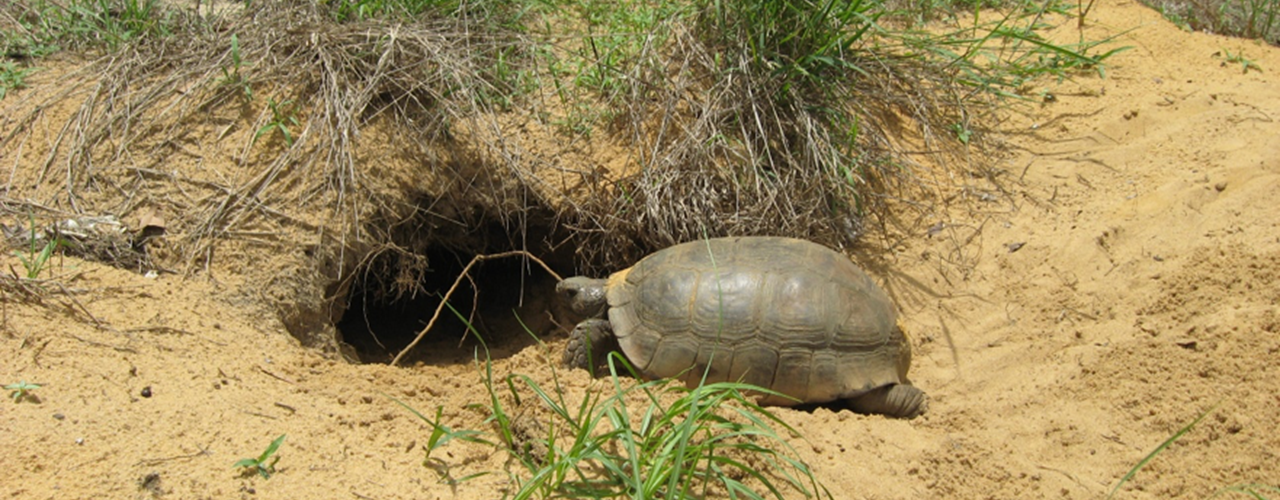The Intersection of Gopher Tortoise Policy and Conservation
Habitat loss, invasive species, disease, overexploitation, pollution—these are just a few of the many threats that species face in their fight for survival and that conservationists try to manage for in their efforts to protect and conserve species. When species are so rare that they are only found in one place on Earth, conservation efforts can be relatively straightforward. For example, the Devil's Hole Pupfish (Cyprinodon diabolis) is only found in a single, deep limestone pool in Death Valley National Park where there are only an estimated 100-500 left in the wild. In the case of the pupfish conservation consisted of two main actions: regulation of groundwater pumping to stabilize water levels in the pool and the creation of the Ash Meadows National Wildlife Refuge to protect the main water source for the pupfish. However, most threatened, endangered, or at risk species do not have such localized ranges, and determining the most effective conservation actions and how to implement those actions is not quite as clear.
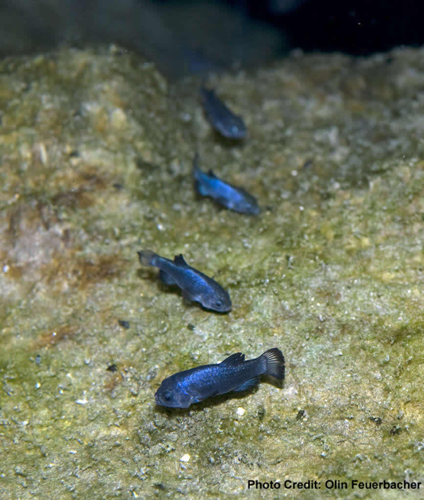
The Devil’s Hole Pupfish (Cyprinodon diabolis). Photo: U.S. Fish and Wildlife Service.
Imagine that the same pupfish is instead found in a large river like the Mississippi; the size of the area needing protection is now enormous, which in turn increases the number and complexity of the threats it faces. For most species, this is the reality. Traditional conservation efforts for these species typically target only one area or one threat at a time, and in turn, the actions needed become much more complex. Effective conservation of species like this require that many different individuals and groups work together to protect habitat and reduce threats. An example of one such successful collaboration already exists among the U.S. Department of Defense (DoD), the U.S. Fish and Wildlife Service (USFWS), conservation groups, and stakeholders in the southeastern U.S.
The DoD holds a considerable amount of land in the U.S., totaling approximately 11.4 million acres across 425 installations. The majority of these lands have not experienced the same rate of large-scale habitat loss from development pressures as non-federally owned land has, and as a result, military installations hold large expanses of relatively undisturbed habitat for a variety of wildlife species. Over 300 species listed as federally threatened or endangered by the Endangered Species Act (ESA) occur on lands managed by the DoD.
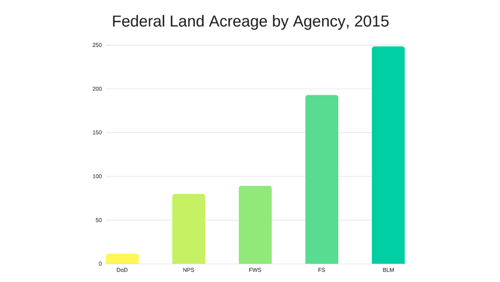
Federal land acreage by agency – from (Vincent et al. 2017) - Department of Defense (DoD), National Park Service (NPS), Fish and Wildlife Service (FWS), Forest Service (FS) and Bureau of Land Management (BLM).
The gopher tortoise (Gopherus polyphemus) is a species of tortoise found in the southeastern United States that excavates and lives in burrows. The gopher tortoise is an important keystone species; its burrows provide habitat for over 360 species across its range, including several legally-protected species such as the Eastern Indigo Snake (Drymarchon corais couperi). Recently, the gopher tortoise has experienced significant population declines, largely due to habitat destruction, fragmentation, and degradation. As a result, the tortoise is listed as threatened under both Florida state law and as Threatened under the federal Endangered Species Act (ESA) in the western portion of its range. Currently, it is a candidate for listing in its eastern range.
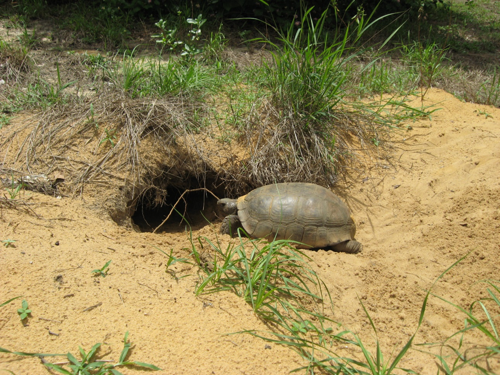
A Gopher Tortoise entering its burrow. Photo credit: Gary Foster
The gopher tortoise inhabits 19 DoD installations in its eastern range as well as the National Guard’s Camp Blanding Joint Training Center in Florida. The ESA requires DoD to protect any federally listed species found on their land, which includes limiting disturbance and impacts during important times of the year (such as during the breeding season for birds) and within important habitat areas when planning training exercises and any construction activities. Often these requirements conflict with planned training and development on base. In the case of the gopher tortoise, however, a revolutionary new strategy - the Gopher Tortoise Conservation and Crediting Strategy (Crediting Strategy) - was enacted after many years of planning and input. The Crediting Strategy specifically protects military training activities and military readiness should the gopher tortoise be listed under the ESA.
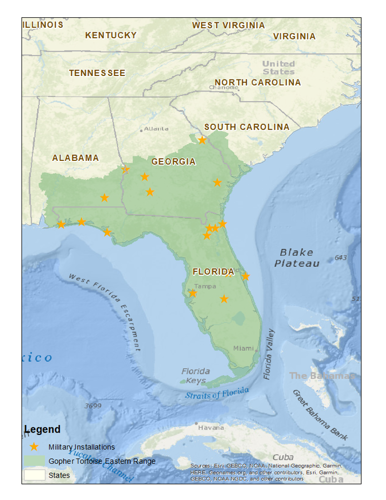
Known Status of the Gopher Tortoise on Military Installations in the Southeastern United States – data from Wilson et al. 1997, Esri 2018 and USFWS 2018b.
The easiest way to think about how the Crediting Strategy works is to think of it as a gopher tortoise savings account. The DoD supports off-base tortoise conservation efforts that are recognized by USFWS, and in turn, they earn credits which are based on the size of the area conserved, the quality of the habitat found in the area, and the number of protected resident or translocated tortoises. The larger the area, the better the habitat, and the more tortoises involved, the more credits the DoD receives and saves in their “tortoise account.” In the event that the eastern population does become listed, these credits can then be used to offset, or mitigate, future DoD activities, such as using a new area of a base to conduct tank training maneuvers or building more roads throughout the base. Further, the support of off-base conservation activities should reduce the likelihood of the tortoise becoming listed under the ESA.
This is a revolutionary policy because, rather than automatically requiring conservation actions to be implemented on or near military installations for federally listed species, the Crediting Strategy promotes conservation of areas of greatest ecological value to gopher tortoises. The Strategy expands the options available for DoD to meet its conservation obligations and creates a powerful new tool to protect military readiness under the ESA. The benefits of this new policy are felt not only by the tortoise but also the other 360 species that rely on the same habitat for their survival. There is hope that similar conservation-driven policies can be implemented for other listed species throughout the United States so military readiness and species conservation can benefit from one another.
--
Edited by Mike Brennan, Program Director - Wildlife Conservation and Mitigation Program, Texas A&M Natural Resources Institute
Edited by Tiffany McFarland, Research Associate - Wildlife Conservation and Mitigation Program, Texas A&M Natural Resources Institute
--
References
Brennan, M. 2018. Lesson from a Tortoise. Western Confluence. http://www.westernconfluence.org/lesson-from-a-tortoise/
Esri. 2018. USA States Shapefile. http://www.arcgis.com/home/item.html?id=1a6cae723af14f9cae228b133aebc620.
National Park Service (NPS). 2017. Devils Hole. https://www.nps.gov/deva/learn/nature/devils-hole.htm.
National Park Service (NPS). n.d. Eastern Indigo Snake: Species Profile. https://www.nps.gov/ever/learn/nature/easternindigosnake.htm.
NatureServe. 2014. Cyprinodon diabolis. The IUCN Red List of Threatened Species 2014: e.T6149A15362335. http://dx.doi.org/10.2305/IUCN.UK.2014-3.RLTS.T6149A15362335.en. Downloaded on 24 April 2018.
U.S. Fish and Wildlife Service (USFWS). 2004. Protecting Endangered Species on Military Lands, Successful Species Recovery. https://denix.osd.mil/nr/threatenedendangeredandatriskspecies/federallylisted/factsheets/fact-sheet-successful-t-and-e-species-recovery-dod-u-s-fish-and-wildlife-service/
U.S. Fish and Wildlife Service, Southeast Region (USFWS), U.S. Department of Defense (DoD), Alabama Department of Conservation and Natural Resources, Florida Fish and Wildlife Conservation Commission, Georgia Department of Natural Resources and South Carolina Department of Natural Resources. 2017. Department of Defense Gopher Tortoise (Gopherus polyphemus) Conservation and Crediting Strategy. https://www.fws.gov/southeast/pdf/strategy/gopher-tortoise-conservation-and-crediting-strategy-department-of-defense.pdf
U.S. Fish and Wildlife Service (USFWS). 2018a. Gopher Tortoise Fact Sheet. https://www.fws.gov/northflorida/gophertortoise/Gopher_Tortoise_Fact_Sheet_web.pdf
U.S. Fish and Wildlife Service (USFWS). 2018b. Species Profile for Gopher tortoise (Gopherus polyphemus). https://ecos.fws.gov/ecp0/profile/speciesProfile?spcode=C044#conservationPlans.
Vincent, C.H., Hanson, L.A., and Argueta, C.N. 2017. Federal Land Ownership: Overview and Data. Congressional Research Service. https://fas.org/sgp/crs/misc/R42346.pdf.
Wilson, D.S., Mushinsky, H.R., and Fischer, R.A. 1997. Species Profile: Gopher Tortoise (Gopherus polyphemus) on Military Installations in the Southeastern United States. Technical Report SERDP-97-10. http://www.fwspubs.org/doi/suppl/10.3996/062015-JFWM-055/suppl_file/062015-jfwm-055.s7.pdf?code=ufws-site



